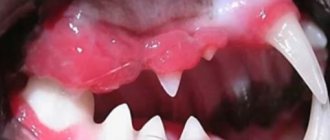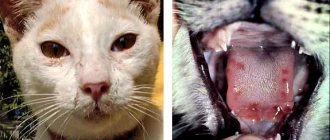Causes of the disease and methods of infection
Tuberculosis of different animal species is caused by different types of mycobacteria. In humans, tuberculosis is caused by Mycobacterium tuberculi; it rarely affects other animals, and cats usually have natural resistance to it (however, this mycobacterium can infect dogs). In cattle, tuberculosis is caused by another species - Mycobacterium bovis. It can affect a number of other animal species, including humans, mice, rats, other rodents, badgers, deer, cats, dogs and ferrets. There is a third species, Mycobacterium microti, which infects mice and cats.
It was believed that a cat becomes infected by the bite of a mouse (or other rodent), but the exact route of transmission of the pathogen has not been 100% established. Cats can become infected through close contact with infected badgers or other cats.
Pathogenesis
Cats suffer from tuberculosis in two stages: primary and secondary. Most often, infection occurs directly through the lungs, but the entry point for infection can also be the oral cavity, a wound on the skin or the mucous membrane of the eye. As soon as the pathogen enters the pet’s body, the activation of the immune system begins: the production of antibodies designed to fight the bacteria.
© shutterstock
In the place where the tuberculosis bacillus has entered, a primary focus of inflammation develops. It can be located in the respiratory organs, pharynx, or tonsils. Then in terms of frequency of lesions are the lymph nodes, intestines and skin. From the main lesion, the bacterium begins to circulate in the blood throughout the body, capable of causing an inflammatory process in other organs.
If the cat has a strong immune system, then the foci of tuberculosis heal over time, and the disease has a closed form. In this case, the pet is a carrier of the infection . And as soon as the body’s immune system fails, the mycobacterium becomes active and spreads throughout the body, which can be considered a transition to the stage of secondary tuberculosis.
Clinical signs
In cats, tuberculosis usually manifests itself in the form of skin lesions in areas that are most easily susceptible to rodent bites - on the paws and face. The lesions may appear as infected wounds or sometimes as large growths on the skin. Less commonly, a cough may occur, as well as vomiting, diarrhea, weight loss, and lethargy. Not all carrier cats show symptoms of tuberculosis.
Due to the non-specificity of clinical signs of the disease in cats, they often go unnoticed. Owners bring their pets to the veterinarian's office thinking the sore is a grass infection or the cough is the flu or a "cold."
Diagnostics
Diagnosis of tuberculosis in cats involves several basic tests. An X-ray examination of the pulmonary structures, as well as ultrasound diagnostics, are carried out to identify possible damage to the internal organs.
In addition, the specialist conducts diagnostics to determine the extent of the damage. To confirm the final diagnosis, a general clinical blood test is performed (allows us to identify some deviations in the composition, absence or deficiency of microelements).
In cats with intestinal tuberculosis, hypercalcemia and anemia are diagnosed.
In a veterinary clinic, smears are stained using the Ziehl-Neelsen method, biopsy and further microscopy of damaged tissue structures are performed. Tissue studies are carried out at the biomolecular level using the PCR (polymerase chain reaction) method.
At the slightest suspicion of tuberculosis in cats, the animal is isolated from other animals and people.
Of no small importance in making an accurate diagnosis is the differentiation of tuberculosis from infectious pathologies such as leukemia, tumor processes, and fungal granuloma.
Rarely, the prognosis for diagnosed tuberculosis in a cat is favorable, mostly cautious or unfavorable.
Treatment
Treatment of feline tuberculosis is a controversial issue. According to the rules, cats with tuberculosis cannot be treated; they are euthanized. Cats with tuberculosis pose a serious danger to society. Treatment for tuberculosis may involve the use of antibiotics that are not approved for use in cats. Often cats need to take several medications over a long period of time to overcome the disease, and even after this course they are not completely cured. There is a risk because treating cats with antibiotics (which are only approved for use in humans) can cause the pathogen to become antibiotic resistant.
Therapeutic measures
Let's repeat it again. Firstly, if tuberculosis occurs in cats (especially in catteries), it is not recommended to treat them. Secondly, veterinarians are required to report a case of disease to the sanitary and epidemiological control authorities. Thirdly, the owners of sick animals will themselves be registered with a phthisiatrician for some time. It is not recommended to joke with tuberculosis!
Even if a cat’s body is affected by a type of mycobacteria that has not been detected in humans, the animal should be protected from contact with children, the elderly, as well as people who have suffered serious illnesses or with weakened immune systems. The treatment regimen is drawn up only (!) by a veterinarian, its duration can be up to several months. In the case of cutaneous tuberculosis, surgery may also be required to quickly remove foci of infection. Mycobacteria are extremely resistant to conventional antibacterial drugs, therefore special drugs are used, and in combination with each other:
- Fluoroquinolones;
- Macrolides;
- Rifampicin;
- Isoniazid (deadly to dogs);
- Clofazimine.
The effectiveness of treatment should be constantly monitored by a competent specialist.
Do cats get tuberculosis?
Despite the fact that cases of this disease are not so frequent, they are still observed. Cats are predominantly affected by the so-called bovine type of infection. It is diagnosed in cattle and can be transmitted through unpasteurized cow's milk and raw meat. In addition, a cat can become infected from a person who is sick with this serious disease.
Causes and routes of infection
In cats, there is a primary and secondary stage of the disease. Mostly infection occurs through the respiratory organs, but infection can also occur through the mouth, scratches on the skin or mucous membranes. When the stick is in the body, the immune system is activated. The production of antibodies is observed that actively fight pathogenic microorganisms.
In the area through which the tuberculosis bacillus has penetrated, the primary focus of the inflammatory process occurs. The respiratory organs, larynx or tonsils are often affected. In addition, the lymph nodes, skin and gastrointestinal tract may be affected. From the main focus of the inflammatory process, the rod circulates throughout the body and can provoke infection of other internal organs.
The resulting lesion can heal on its own with normal functioning of the animal’s immune system.
If the pet has good immunity, the lesion heals after a certain period and the disease becomes closed. However, despite this, the cat remains a carrier of the infection. When there are disturbances in the functioning of the immune system, the pathogenic microorganism is activated and begins to further spread throughout the body. This process in veterinary medicine is called secondary tuberculosis.
As for risk groups, they include small kittens and elderly animals. If we talk about the former, their immune system is not yet fully formed. If we are talking about adult cats, then, on the contrary, the immune system is seriously weakened. The risk group also includes pets that suffer from various diseases. Animals kept in nurseries where sanitary and hygienic standards are violated are also susceptible to developing the disease. In this situation, the pathology is transmitted from one cat to another.
What symptoms will indicate the disease?
The signs of tuberculosis in cats are almost identical to this disease in dogs. Symptoms are directly related to where the focus of the inflammatory process is located. If the tuberculosis bacillus has infected the intestines, which often occurs when consuming raw meat and milk, cats experience vomiting and diarrhea. The animal rapidly loses body weight and its appetite decreases. Owners may notice that a previously energetic and cheerful cat has become apathetic and weak, constantly sleeping.
Lameness in an animal may be a consequence of pathogen penetration into its bones.
Damage to the skin occurs upon contact with other felines. Wounds occur on the epidermis that do not heal even with the use of wound-healing medications. If you examine, you may notice enlarged lymph nodes. When the tuberculosis bacillus penetrates into the deep layers of the skin, bone and muscle tissue is damaged. In such a situation, the cat begins to limp.
If the lungs are affected, which occurs through airborne droplets, the cat suffers from a cough and shortness of breath. A dangerous symptom is bleeding in the respiratory organs. Since immunity is greatly reduced, additional infections may occur. Tuberculosis can also affect the visual organs. In this case, you may notice redness of the mucous membrane and protein, increased production of tears, and photophobia. Purulent discharge is often observed from the eyes.
If all organs are affected at once, this type of disease is called generalized. The animal becomes very weak, wounds affect large areas of the epidermis, and ulcers appear. This species is the most dangerous for all mammals.
Symptoms
The location of symptoms varies depending on where the infection enters the body:
- When the intestines are damaged after consuming contaminated meat (mouse hunting) or milk, intoxication of the body occurs with lack of appetite, diarrhea and weight loss.
- In active “combat” cats, infection occurs through wounds received on the face, head and limbs upon contact with sick animals. Subsequently, the lymph nodes under the lower jaw and in the neck area are affected, and non-healing ulcers appear on the body. If the infection enters the skeletal system through soft tissue, the animal may experience lameness.
When bacteria enter the respiratory system, a constant rough cough, hoarse, heavy breathing, and shortness of breath appear.
In the future, pulmonary hemorrhages may develop. Pulmonary tuberculosis is often accompanied by secondary infections, as the body's immune defense is significantly reduced.
- Eye tuberculosis is accompanied by inflammation of the eyelids and conjunctivitis.
- When the whole body is affected - generalized tuberculosis - the symptoms are most severe:
- non-healing wounds;
- diarrhea;
- vomit;
- loss of appetite;
- weight loss;
- weakness;
- proliferation and enlargement of lymph nodes.
At this stage, the disease is most dangerous and contagious.
Signs and symptoms
Manifestations of tuberculosis disease in cats depend on the method in which the animal became infected.
If your cat is infected by eating contaminated food, you will experience the following symptoms:
- Damage to the digestive organs, which leads to diarrhea, bloating, vomiting and, as a result, weight loss. The disadvantage of such symptoms is that it can be confused with a regular intestinal infection and treated in a completely different way. Because of this, the infection passes into the lymph and then into the organs, thereby causing full-fledged tuberculosis.
If the cat is infected through wounds on the body, bites, you will observe the following symptoms:
- Wounds that do not heal and look like swollen nodules.
- Swelling of the lymph nodes; when pressing on them, the cat experiences discomfort and pain.
- If the infection spreads further throughout the body and enters the lungs, coughing, wheezing, and difficulty breathing will occur.
- At the end of mating, the cat weakens, loses weight and becomes lethargic.
- If the tuberculosis infection that entered through the wound settles in the bone and muscle tissue, then the cat will experience weakening of the muscles, which leads to lameness.
Basic information and symptoms
Tuberculosis in cats is diagnosed quite often in veterinary medicine. The main routes of transmission of infection are airborne and nutritional. A healthy, susceptible animal can become ill through contact with sick animals, as well as through contact with contaminated objects, feed, meat and dairy products affected by mycobacteria.
There is also a whole risk group that includes pets kept in crowds and in poor conditions. Infection occurs through close contact with each other. This also includes cats that have poor immune defense (as a result of problems with the immune system, the cat’s body is not able to fight even small amounts of the penetrating pathogen).
The risk of infection with tuberculosis sticks also occurs in small kittens, as well as animals older than 7 years. Small kittens have weak immune defenses, but older animals have a number of chronic systemic diseases that significantly worsen all metabolic processes in the body.
Tuberculosis can occur in two stages - primary and secondary. The animal becomes infected by airborne droplets through the respiratory tract. Quite rarely, the infection penetrates through damaged mucous membranes and skin.
At the site of penetration of pathogenic bacteria, a focus of the inflammatory process occurs. The respiratory system, tonsils and pharynx are primarily affected. Further, the pathology covers the skin, digestive tract and lymphatic system. When mycobacteria penetrate, the immune system begins to actively produce antibodies.
As the disease progresses, mycobacteria spread throughout the body along with the blood, affecting large areas and internal organs. Individual foci of tuberculosis form in the affected organs. Cats with strong immunity are able to fight off infection. In their body, tuberculosis foci of inflammation are covered with capsules, and the disease itself takes on a closed form. The pet spreads the infection into the environment. With a sharp decrease in immunity, the foci become more active, and the disease enters the second stage.
The danger of the disease is that it can easily be transmitted from cat to person and back. Thus, a cat can become infected with tuberculosis from a person, and in turn, the cat can infect its owner with mycobacteria.
The first symptoms of tuberculosis in cats occur depending on where and under what conditions the infection occurred. Depending on the route of infection, symptoms may also vary.
If the route of infection is nutritional (the cat became infected by eating contaminated fresh meat, dairy products or from an infected rodent), symptoms arise from the digestive system. This happens when foci of inflammation form in the intestinal area. Dyspeptic disorders occur (eruption of gastric contents, weight loss, profuse diarrhea).
When a healthy animal comes into contact with a sick animal, signs of tuberculosis look like wounds forming on the animal’s skin, as well as lymph nodes (around the pharynx) increasing in size. In some cases, mycobacterial damage to muscle and bone structures is diagnosed. Tuberculosis of the skin can be in the form of a nodular subcutaneous lesion, a focal form, or tumor-like formations.
Infection of cats by airborne droplets leads to damage to the pulmonary structures. The cat develops a strong barking cough. Against this background, breathing problems develop and bleeding occurs in the lungs. Tuberculosis in cats, developing in the respiratory tract, is also characterized by pharyngitis and inflammatory processes in the tonsils.
Rarer forms of tuberculosis affect the conjunctiva of the eyes, complicated by inflammation of the eyelids. Tuberculous granulomas form on the cornea. The most dangerous form of mycobacteriosis in cats is generalized. This type of infection is characterized by damage to almost all internal systems.
The main symptom of generalized mycobacteriosis is a sharp decrease in immunity in cats; wounds and injuries take a long time to heal. Symptoms of poisoning of the body with metabolic products of mycobacteria occur - weakness, refusal to eat, eruption of gastric contents, weight loss. This form of infection is the most contagious.
What is tuberculosis in cats?
Tuberculosis in cats, as well as in humans, is a consequence of the penetration of the tuberculosis bacillus into the body. It affects internal organs and circulates throughout the body along with lymph.
Veterinarians use the classification of this disease in cats:
- Tuberculosis, which affects the lungs.
- Leprosy. In another way it is called leprosy. This type of tuberculosis affects the skin and subcutaneous tissues.
- Tuberculosis as a secondary infection. It occurs with a clear decrease in immunity.










